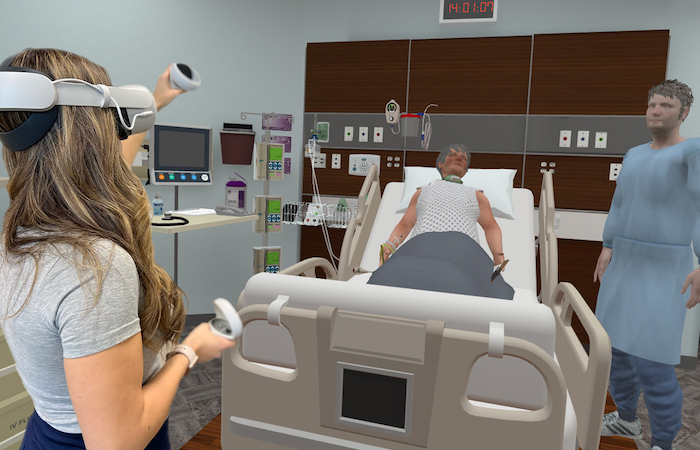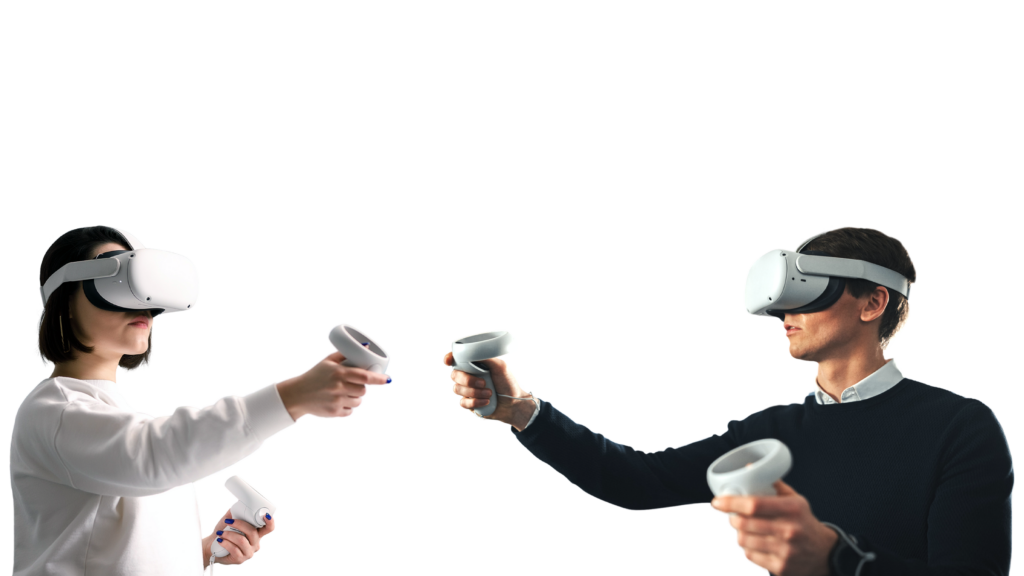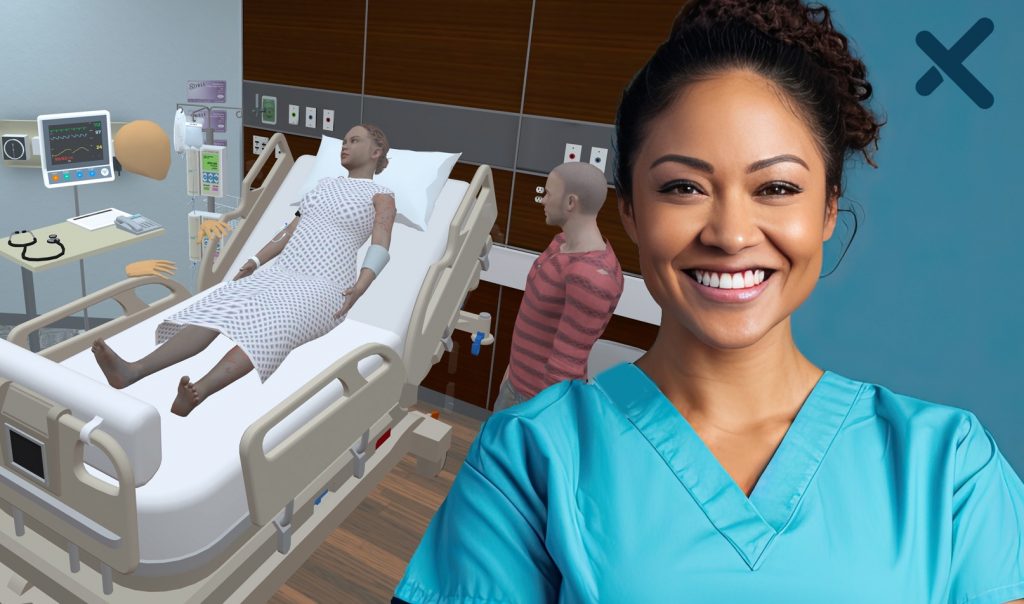SimX is completely changing the way healthcare providers undergo simulation training. For decades, patient manikins have evolved to incorporate varying...
Empowering Nurses: 5 Ways SimX is Transforming Nursing Education

Are you looking to enhance your nursing sim program in 2024? Simulation training is considered one of the best ways to prepare both experienced nurses and students to provide quality comprehensive care. Whether you utilize traditional manikins or high-fidelity Virtual Reality (VR) scenarios, simulation training can greatly improve clinical judgment and other essential nursing skills necessary for certifications and licensure.
Integrating VR with immersive and realistic simulated patient encounters into your sim program is a cost-effective and accessible solution to improve sim training and curriculum efficacy. Here are 5 ways you can enhance your simulation experience using VR.

1. Customize Your Nursing Curriculum
The best solution for simulation training is not a one-size-fits-all approach. Any learner’s needs and learning objectives will vary depending on skill level, specialty, team size, and even the amount of time available for training. Customize your curriculum to allow your simulation training to be flexible, accessible, and immersive for your students right now.
With in-headset VR simulation training, you can choose from hundreds of patient encounters in the SimX marketplace or utilize SimX’s partnerships with Elsevier and other nursing educators to curate a curriculum that is right for you. In doing so, you can build a custom simulation experience that prioritizes your specific learning objectives.
2. Prioritize Experiential Knowledge
Gaining experiential knowledge is essential for developing and perfecting many core nursing skills and abilities. Many simulation training programs try to mimic experiential learning but fail to deliver realistic environments and patient encounters. While there is no real replacement for years of hands-on experience, learners can greatly benefit from the diversity and immersion of advanced VR patient encounters. VR enables learners to participate in critically important scenarios they may never experience during clinical training. They can then repeat accessible programs and scenarios as many times as they want, increasing the efficacy of custom curricula.
SimX’s nursing content is created by nurses for nurses and so relies heavily on the real-life experiences of the SimX team and our customers. The result is the largest virtual marketplace of realistic, immersive patient encounters representing many specialties and covering multiple skill sets that learners can immediately apply to in-person patient interactions.

3. Practice Simulation in Teams
Gaining more experiential knowledge in teams is essential for nurses and practitioners to develop the skills needed to thrive in any environment. Team training improves communication skills, decision-making, and task delegation in diverse scenarios. This is especially relevant for nurses who may often find themselves as part of an interprofessional team with varying specialties and skill sets.
The SimX patented multiplayer technology allows multiple learners to collaborate in the same space. Each simulated patient encounter has multiplayer functionality for co-located and non-co-located training groups. This allows SimX users to quickly adapt to remote and in-person learning opportunities, improving communication and collaboration skills. This means that guest lecturers, fellow learners, and facilitators can all be in different locations–different countries, even–and still learn and train together.
4. Focus on building Psychosocial Skills
Developing and practicing psychosocial skills–including therapeutic communication with patients and families–is imperative as successful patient interactions rely heavily on medical professionals’ emotional and social intelligence. Effective therapeutic communication and psychosocial skills can help nurses increase the accuracy of a diagnosis, determine the best patient care, and improve the identification of a patient’s fears, anxieties, and understanding of treatment options.
Current simulation training for nurses does not often include realistic or immersive psychosocial skill development. Any training that does include this is infrequent, inaccessible, and costly. SimX’s VR simulation training allows nurses to access the relevant knowledge and skill development they need to be successful in all areas of care. In many of our nursing scenarios, learners must deal with social and emotional issues between patients, their families, and other practitioners. These interactions, facilitated by educators and administrators, require learners to practice and repeat therapeutic communication and decision-making skills.

5. Utilize the Laerdal Circle of Learning
The Laerdal Circle of Learning is a tool that can be used to “plan and execute improvement programs where education and training are key.” When planning to expand, enhance, and execute a nursing simulation program, learning guides from industry experts can help shape the process and ensure success for both learners and educators. There are 6 points to the Circle of Learning, summarized below. Study each point, not only for “obtaining knowledge and skills, but also for developing the critical-thinking skills needed for competent healthcare providers.”
– Healthcare Quality Improvement (HQI): Continually practice to create positive change within healthcare, which may include considering human behaviors, process improvements, or cultural changes.
– Knowledge Acquisition: Consider learning processes and explore advanced systems that offer knowledge in various formats and levels to build the skills necessary to meet your goals.
– Skills Proficiency: Whether working alone or in a team, building skills is vital to providing the best treatment possible.
– Decision Making: VR simulation training is a great option for building decision-making skills in immersive learning environments and preparing learners to better interact with real-life patients.
– Simulation in Teams: This type of training will improve teamwork, communication, and build leadership skills.
– Actional Insights: After working through each portion of the circle, you are ready to collect and analyze data on a learner’s behavior and performance through each step. Educators and administrators can then provide quality, comprehensive feedback and turn data into actionable insights.
Traditional nursing education has relied heavily on textbooks, manikins, and limited patient interactions. While these methods have their merits, they often fail to prepare students for the dynamic and often unpredictable nature of real-life patient encounters. This is where VR, and particularly SimX VR, bridges the gap. Building custom simulation curricula, prioritizing experiential knowledge, practicing team training, focusing on psychosocial skills, and utilizing learning tools from industry experts will help learners build essential skills and gain greater confidence to care for real-life patients.
Explore the SimX marketplace and build your custom nursing curriculum now using virtual patient encounters created in partnership with nursing experts worldwide.
